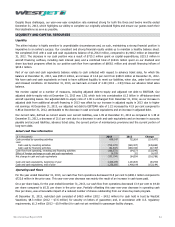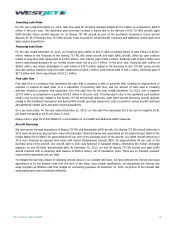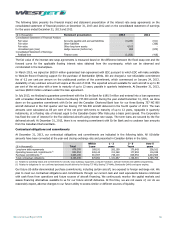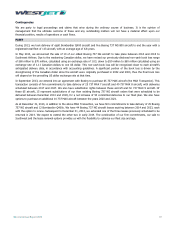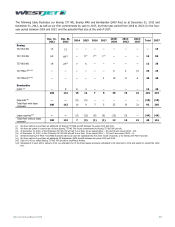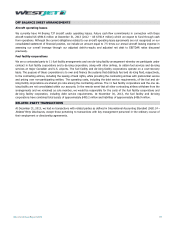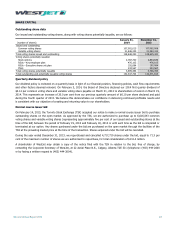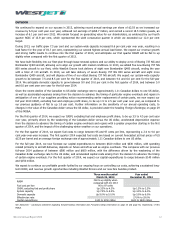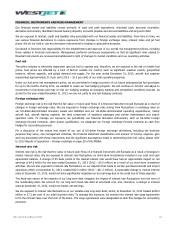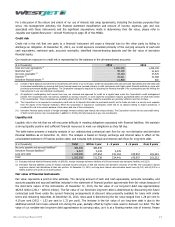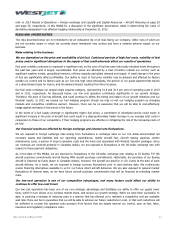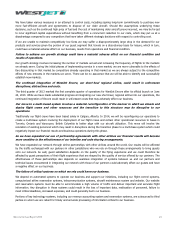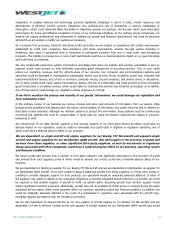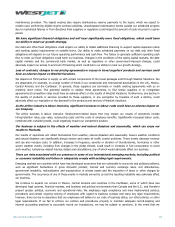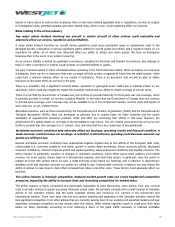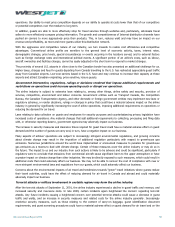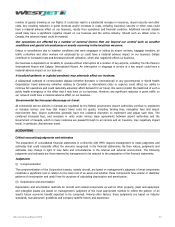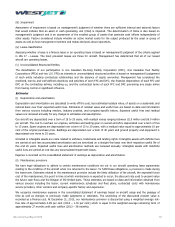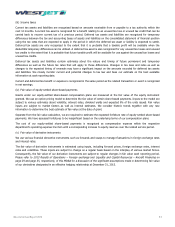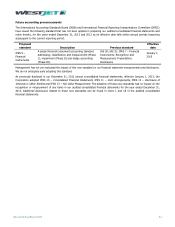Westjet 2013 Annual Report Download - page 44
Download and view the complete annual report
Please find page 44 of the 2013 Westjet annual report below. You can navigate through the pages in the report by either clicking on the pages listed below, or by using the keyword search tool below to find specific information within the annual report.
WestJet Annual Report 2013 44
refer to
2013 Results of Operations – Foreign exchange and Liquidity and Capital Resources – Aircraft Financing
on page 29
and page 35, respectively, of this MD&A for a discussion of the significant assumptions made in determining fair value of
derivatives designated in an effective hedging relationship at December 31, 2013.
RISKS AND UNCERTAINTIES
The risks described below are not intended to be an exhaustive list of all risks facing our Company. Other risks of which we
are not currently aware or which we currently deem immaterial may surface and have a material adverse impact on our
business.
Risks relating to the business
We are dependent on the price and availability of jet fuel. Continued periods of high fuel costs, volatility of fuel
prices and/or significant disruptions in the supply of fuel could adversely affect our results of operations.
Fuel price volatility continues to represent a significant risk, as the cost of fuel has seen historically elevated levels throughout
the past few years and is largely unpredictable. Fuel prices are affected by a host of factors outside our control, such as
significant weather events, geopolitical tensions, refinery capacity and global demand and supply. A small change in the price
of fuel can significantly affect profitability. Our ability to react to fuel price volatility may be delayed and affected by factors
outside our control and by factors such as our low-cost high value philosophy, the portion of our guest segment that travels
on a discretionary basis for leisure, and the demand impact resulting from fare increases.
Our fuel costs constitute our largest single expense category, representing 31.9 and 32.5 per cent of operating costs in 2013
and in 2012, respectively. As discussed below, our low cost operation contributes significantly to our growth strategy.
Therefore, the price of fuel has affected, and could continue to affect, the timing and nature of our growth initiatives and our
financial results. In 2012 we ceased our fuel hedging program though we may re-visit our hedging program as changing
markets and competitive conditions warrant. However, there can be no assurance that we will be able to cost-effectively
hedge against increases in fuel prices in the future.
In the event of a fuel supply shortage or significantly higher fuel prices, a curtailment of scheduled service could result. A
significant increase in the price of aircraft fuel could result in a disproportionately higher increase in our average total costs in
comparison to those of our competitors, if their hedging programs are effective in mitigating the risk of the increasing costs of
jet fuel.
Our financial results are affected by foreign exchange and interest rate fluctuations.
We are exposed to foreign exchange risks arising from fluctuations in exchange rates on our U.S.-dollar-denominated net
monetary assets and liabilities and our operating expenditures, mainly aircraft fuel, aircraft leasing expense, certain
maintenance costs, a portion of airport operation costs and the hotel cost associated with WestJet Vacation packages. Since
our revenues are received primarily in Canadian dollars, we are exposed to fluctuations in the US-dollar exchange rate with
respect to these payment obligations.
As of the date of this MD&A, we are exposed to fluctuations in the US-dollar exchange rate relating to 25 Boeing 737 NG
aircraft purchase commitments and 65 Boeing MAX aircraft purchase commitments. Historically, the purchase of our Boeing
aircraft is financed by funds drawn in Canadian dollars; however, the aircraft are paid for in U.S. funds at the date of each
aircraft delivery. As a result, we are exposed to foreign currency fluctuations prior to each delivery date. We continuously
review financing alternatives available to us for our future direct aircraft deliveries. We are also exposed to general market
fluctuations of interest rates, as we have future aircraft purchase commitments that will be financed at prevailing market
rates.
Our low-cost operation is one of our competitive advantages, and many factors could affect our ability to
continue to offer low-cost travel.
Our low cost operations has been one of our core strategic advantages and facilitates our ability to offer our guests lower
fares, which in turn allows us to increase market share, and pursue our growth strategy. While we have been successful, to
date, in pursuing a strategy of reducing costs in a manner that has allowed us to maintain a competitive cost per available
seat mile, there can be no guarantee that we will be able to achieve our future reductions in cost, or that such reductions will
be sufficient to counter the upwards costs pressure from factors that are largely beyond our control, such as fuel, labor,
insurance and regulatory compliance costs.


